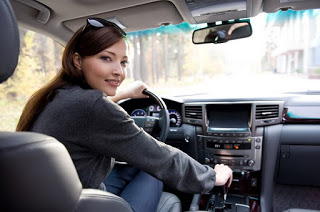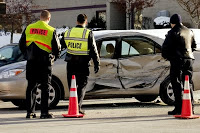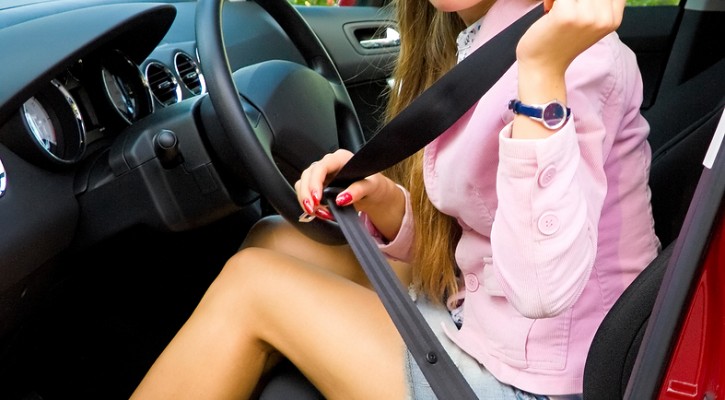Tag Archive: teen driver

Effectiveness Of In-Vehicle Monitoring Systems For Teen Drivers
November 9, 2011
The Insurance Institute for Highway Safety (IIHS) conducted an interesting experiment in 2009 that tested the effectiveness of various in-vehicle monitoring systems on teen drivers. The study monitored the driving habits of 84 teen drivers with different types of in-vehicle technology to determine which ones had the greatest effect on both the teen drivers and their parents.
IIHS installed their own monitoring equipment in the study vehicles that recorded when drivers braked sharply or accelerated suddenly, didn’t use belts, and exceeded speed limits. The monitors used GPS and a satellite modem to transmit the data to a central processing facility and the data was made available for parents to review. In addition to its own monitoring systems, IIHS also installed different types of in-vehicle monitoring that are commercially available to parents of teen drivers. The 84 subjects were randomly assigned into four groups:
“Drivers in groups 1 and 2 heard audible alerts for risky maneuvers. A short, low-pitched buzz sounded for sudden braking and acceleration. A continuous low-pitched buzz sounded when the belt wasn’t buckled and stopped only when it was fastened. Speeding triggered a single beep at 2.5 mph over the posted limit, followed by continuous beeps at increasing pitch and frequency when the teenage drivers exceeded the limit by more than 10 mph.” For drivers in group 1, the information was immediately recorded and transmitted to the parents for review. The drivers in group 2 had the opportunity to correct their behavior and, if corrected within 20 seconds, prevent a report from being sent to their parents.
There were no in-vehicle alerts for drivers in group 3, just website notification. Group 4, the control group, was monitored but had no alerts or web notification.
The different types of monitoring systems included:
- Basic systems: CarChip Pro – http://www.carchip.com/Products/8226.asp, CarChipPro is essentially a black box that plugs into the car’s diagnostic recorder. The system can record speed, mileage, and other data. Once the information is downloaded, it provides parents with a history of the teen’s driving. The system may also be set to turn into an alarm if certain speeds are reached or if the driver is braking too hard. The system is a tool to help discuss a teen’s driving habits by allowing parents to show them the facts, and how to correct their driving behavior.
- GPS-based systems: Inthinc’s Tiwi – http://www.inthinc.com/products/tiwifamily This system monitors drivers in real-time by providing in-vehicle, verbal feedback to the driver when they are speeding, not wearing their seat belt or driving aggressively. Also, parents can be notified immediately of unsafe driving behavior (through text, voicemail or email) and all info is reported through an Internet-based portal for later review and discussion between parent and teen. This system gives teens a chance to correct their behavior before their parents are notified.
- Video systems: DriveCam: Teen Safe Driver Program package – http://www.drivecam.com/, This in-car camera system records “risky driving behavior” and sends them to DriveCam for third-party assessment of a teen driver’s skills. The reports are then sent to parents, who can discuss the driving behavior with their teen.
- Smart keys: MyKey – http://media.ford.com/article_display.cfm?article_id=29172, First seen on the 2010 Ford Focus, the MyKey system is designed to help parents set certain limitations on their Ford vehicles for when their teens are driving. With the configurable key, this system is designed for parents who share their cars with teen drivers. Ford has announced that this technology will be available in all Ford vehicles beginning in 2012. The key features are:
- Do Not Disturb, prevents use of cell phone and texting while the car is in motion.
- Speed Control, limiting the top speed of the Ford vehicle to 80 mph.
- Volume control, which allows parents to set a maximum volume level for the car’s radio.
- Beltminder, an alarm system that mutes the radio and plays a chime every 6 seconds, every minute or every 5 minutes when the seatbelt is unbuckled.
- Fuel reminder: alerts the teen that they need to refuel, when fuel is low.
The results of the study were as follows:
- Seat belts – Seat belt use was already at a 94% level when the study began but increased among all four groups when the drivers were faced with a continuous buzzing or chiming noise. This has been found to be effective among all age groups.
- Stops and starts – Sudden braking and rapid starts can indicate aggressive driving or inattention to the driving environment. Sudden stops and starts fell in all groups relative to the control group but was especially significant group 1 with immediate web notification to their parents. The effects were even greater among those whose parents received periodic report cards.
- Speeding – Speeding was the most prevalent risky behavior noted among all groups. Speeding up to ten mph over the posted speed limit fell among the groups with alerts in their vehicles but then started to rise over time. Speeding was only significantly reduced among the groups whose parents were notified or those who had a chance to correct the problem before parental notification.
- All risky behaviors – Risky behaviors declined most among the two groups with parental notification but were most noticeable among group 2, the ones who had a chance to correct their behavior before parental notification. Risky behavior was somewhat higher in group 1, apparently because it was too late to correct the behavior and their parents were going to be notified anyway.
Parents will want to consider the results of this study when choosing an in-vehicle monitoring device for their teen driver.

Teen Passengers of Teen Drivers
October 18, 2011
As teen passengers in a car with a teen driver, would you or could you ask the driver to:
- stop texting,
- stop talking on a cell phone,
- buckle up,
- not drink and drive,
- slow down, or;
- pay more attention to the road ahead?
All of these activities are dangerous yet teen passengers of a teen driver seem to be reluctant to ask the driver to drive more safely and they pay dearly as a result.
Car crashes are the leading cause of death for teens and more than half of the teens killed in car crashes each year are passengers of another teen driver. A study by The Children’s Hospital of Philadelphia found that 60 percent of teens think inexperience heavily influences safety, but only 15 percent consider their peers to be inexperienced. Apparently, teens equate experience with the ability to pass the driving test and earn a license rather than time on the road and exposure to a variety of driving situations.
A recent study by the AAA Foundation for Traffic Safety, showed that teen drivers are about 50 percent more likely to crash in the first month of unsupervised driving than they are after a full year of experience driving on their own, and they are nearly twice as likely to crash in their first month as they are after two full years of experience.
Distracted driving is one of the leading causes for crashes among all age groups but it is especially high among teen drivers. Teen passengers add to the distractions and the risk of a crash increases with each additional teen passenger yet only 10 percent of teens realize that carrying teen passengers increases the risk of a crash.
Another factor leading to teen passenger deaths is that teens have the lowest rate of seat belt use and they are less likely to wear a seat belt when they are a passenger of another teen than when they are driving alone.
The website www.teendriversource.org, has produced an informational brochure called “Teach Your Teen To Be A Smart Passenger”. Parents continue to be the strongest influence in a teen’s life and, by setting strong rules for teens, both as a driver and a passenger, they can help prevent some of the dangerous situations that teens are prone to get into.

5 Things A Teen Driver Must Do To Handle A Crash
May 9, 2011
If you compare industrialized nations, some may say the US has a poor record of teaching young drivers how to drive. Instead of the requirement to be taught by professional driving instructors, American teens are taught to drive by their parents who, with few exceptions, are ill prepared to teach their teen how to drive. As a result, many teens are sent out on the road without the proper training or experience to handle a lot of the driving situations they will be faced with. Unfortunately, in the United States, that means that the chances of a teen becoming involved in a collision within the first year of driving are very high. Since the chances of a teen driver being involved in a motor vehicle collision are so high, teens should, at least, be prepared to deal with the aftermath of a crash.
Here’s a brief checklist of what a teen driver must know, when involved in a crash:
Don’t place blame, remain calm – This is much easier said than done given the emotions involved in a crash however, remaining calm can help defuse a potentially volatile situation. Tempers can flare after a crash and there is the potential for a “road rage” attack. Losing one’s calm can’t “un-crash” the vehicles so it is imperative that the teen remain as calm as possible. If the other driver becomes confrontational, stay in the car and wait for the police. There may be a temptation to run but the teen should be aware that he or she could be arrested for leaving the scene of a collision.
Check immediately for injuries to other drivers. Call Rescue, if necessary. – If anyone involved was hurt, the first priority is to call 911 for medical assistance. First aid should be applied to stop bleeding but, to prevent even greater injuries, an injured victim should never be moved unless there is a greater chance of further injury from fire or a secondary collision from oncoming traffic. Never give injured victims any water.
Emergency packs – Your car should be stocked with first-aid kits, emergency flares or reflectors, tools, and any other items that may help in case of a crash. Reflective triangles or flares placed at least 100 feet away from the crash will help to divert other traffic away from the crash site. If the collision occurred around a sharp curve or other obstruction, someone should be sent to wave down or otherwise warn oncoming traffic of the danger ahead.
If the vehicles can be moved, they should be moved off the roadway as quickly as possible. If the vehicles can’t be moved, all victims who are capable of walking should be moved well off the roadway to a safe location to avoid secondary collisions.
License, insurance, and registration – Your teen should always know where the vehicle’s registration and proof in insurance card are located. They should always be kept together in an envelope in the glove box. Most state laws require that drivers who are involved in a crash share their driver’s license number, vehicle registration, proof of insurance, and current address with law enforcement officers and other persons involved.
In most states, if a collision results in more than $500 in damages either to vehicles, or public or private property, the police must be called. If the police are not called, a formal report must be made to local law enforcement within 24 hours.
Documentation – Nowadays, with cell phones, a camera is never far away. Take pictures of the crash site and any damages that may have occurred. Note and take pictures of conditions, such as weather, roadway hazards, or whether or not the sun’s position may have blinded a driver, etc. Get the names and phone numbers of any witnesses. If the collision results in a court case, having as much documentation as possible will help.
A car crash is no time to panic or lose one’s cool. Handle it properly and there will be fewer hassles, in the long run, for the teen driver.

State Farm Insurance Teen Driver Programs
March 2, 2011
State Farm has created an Auto Learning Center, which is their driving safety blog. They have several features specifically aimed for teen drivers and parents of teen drivers that reinforce the idea that safe driving begins from home, and that they are more than just an insurance company.
Here are several of their discounts that teen drivers can take advantage of:
Good Student Discount (Up to 25%) – For students who are under the age of 24, high grades are directly proportional to lower insurance rates. This may apply for students under the age of 25 who are taking a four-year course in a college/university.
Defensive Driving Course Discount (Up to 10%) – This is for teens who take a defensive driving course voluntarily. State Farm believes that granting a discount for drivers who are conscious about the way they drive should be rewarded by discounts.
Steer Clear Safe Driver Discount (Up to 15%) – Steer Clear is State Farm’s own version of a driver refresher course. They reward drivers who take up the initiative to apply for their course by a discount of up to 15%.
There are currently three ways to avail of this discount: via an insurance agent, online or via the mobile app. The insurance agent will be able to give teen drivers a Steer Clear kit which includes program materials. The online option allows teen drivers to be able to take up the Steer Clear refresher course in the comfort of their own home. The mobile option is by far the simplest way: simply installing their app (which is available for i-devices or Android devices), they may be able to avail of the Steer Clear Discount.

Allstate Insurance Teen Driver Programs
January 20, 2011
Allstate is considered to be one of the largest insurers in the country. While they provide several types of insurance, their auto insurance has a few teen driver discounts and safe driving programs worth noting.
Allstate follows the belief that good driving behavior in teens is worth rewarding. They have several campaigns that help spread the message of safe driving operation, most of which are targeted at teens and their parents. Here are some of the discounts that are applicable for teens:
Good Student discount – Applicable for teens who are younger than 25 and are full-time students. Good grades may qualify them for a discount on their auto insurance.
Defensive Driver discount – Teens who show initiative by taking a state-approved defensive driving course will be able to receive a special discount on their auto insurance rate. To note, this does not apply to court-appointed classes.
Drive Wise campaign – The newest campaign that Allstate is promoting, the Drive Wise campaign, is an opt-in discount program targeted for drivers who know that they are already practicing safe driving habits. This is a great opportunity to save money, especially for teen drivers who are taught from the get-go that driving safe is the only way to drive. Over time, drivers may get UP TO 30% discount on their auto insurance premium. How Drive Wise works is a driver will agree to have the Drive Wise device installed in their vehicle. The device is different from a GPS device, in that it gauges driver performance based on mileage, driving time of the day, hard or extreme braking and maximum speed, instead of location. Once satisfactory performance conditions are met, the discounts are applied. The discount awarded will initially be 10% upon signing up for the campaign.
Allstate has found a way to reward their customers with incentives that translate to saving customers money. Allstate features several attractive discounts when it comes to auto insurance and promoting safe driver behavior. Developing and maintaining safe driving habits will always be a driver’s best form of insurance.
Learn more about vehicle safety features that may lower your teens auto insurance.
